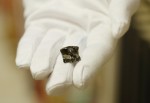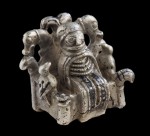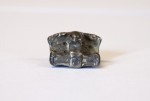 A very rare and very tiny chair-amulet from the Viking era has been discovered on the Danish island of Lolland. Metal detectorist Torben Christjansen, whom you might recall from the killer Thor’s Hammer amulet he discovered in 2014, found it in a field near Nybølle on the west side of the island. He had scanned the field before, lured by its black soil which is sometimes and indication of ancient activity, and found 65 objects, but he’d never seen anything like this little piece. Christjansen brought the artifact to Anders Rasmussen, curator at Museum Lolland-Falster, who identified it as a Viking chair-amulet.
A very rare and very tiny chair-amulet from the Viking era has been discovered on the Danish island of Lolland. Metal detectorist Torben Christjansen, whom you might recall from the killer Thor’s Hammer amulet he discovered in 2014, found it in a field near Nybølle on the west side of the island. He had scanned the field before, lured by its black soil which is sometimes and indication of ancient activity, and found 65 objects, but he’d never seen anything like this little piece. Christjansen brought the artifact to Anders Rasmussen, curator at Museum Lolland-Falster, who identified it as a Viking chair-amulet.
 No larger than a fingernail, the amulet depicts a wide chair with an abstract figure seated on it. On either side of the back of the chair are two smaller figures meant to represent ravens. The figure may be Odin, who according to an Icelandic saga from the 13th century, sat on a great chair named Hlidskjalf and observed our mortal goings-on from there. He would send his two ravens, Hugin and Munin, to explore the world and report back on what they’d seen during their voyage.
No larger than a fingernail, the amulet depicts a wide chair with an abstract figure seated on it. On either side of the back of the chair are two smaller figures meant to represent ravens. The figure may be Odin, who according to an Icelandic saga from the 13th century, sat on a great chair named Hlidskjalf and observed our mortal goings-on from there. He would send his two ravens, Hugin and Munin, to explore the world and report back on what they’d seen during their voyage.
 Only 15 or 20 chair-amulets have been found in Scandinavia, and just two of them in Denmark. One was found in Hedeby, an important Viking trade center now just over the Danish border in Schleswig-Holstein, Germany. The other at Lejre in Zealand in 2009. They have differences in design but all date from the late 10th and early 11th centuries. The amulets from Hedeby, Lejre and Nybølle are also quite different, but they share one thing in common. Two things, actually: the clearly identifiable ravens on the back of the chair.
Only 15 or 20 chair-amulets have been found in Scandinavia, and just two of them in Denmark. One was found in Hedeby, an important Viking trade center now just over the Danish border in Schleswig-Holstein, Germany. The other at Lejre in Zealand in 2009. They have differences in design but all date from the late 10th and early 11th centuries. The amulets from Hedeby, Lejre and Nybølle are also quite different, but they share one thing in common. Two things, actually: the clearly identifiable ravens on the back of the chair.
 The ravens strongly suggest that the shape in the chair represents Odin and the Lejre amulet, which is larger with more detailed carving, certainly features Odin. So it’s a reasonable assumption that Odin is sitting in this chair too, but it’s so amorphous a shape it could represent another character from the Norse mythology, an animal or perhaps another deity naughty enough to keep Odin’s seat warm for him.
The ravens strongly suggest that the shape in the chair represents Odin and the Lejre amulet, which is larger with more detailed carving, certainly features Odin. So it’s a reasonable assumption that Odin is sitting in this chair too, but it’s so amorphous a shape it could represent another character from the Norse mythology, an animal or perhaps another deity naughty enough to keep Odin’s seat warm for him.
 The area where the amulet was found has proven to be rich with Iron Age and Viking artifacts; jewelry, coins, rune stones and silver hoards have all been found near where the amulet was discovered. Archaeologists believe that Lolland, while not the large trade center that Hedeby and Lejre were in their medieval heyday, must have been very wealthy and prosperous for centuries.
The area where the amulet was found has proven to be rich with Iron Age and Viking artifacts; jewelry, coins, rune stones and silver hoards have all been found near where the amulet was discovered. Archaeologists believe that Lolland, while not the large trade center that Hedeby and Lejre were in their medieval heyday, must have been very wealthy and prosperous for centuries.
The amulet is heading to the National Museum where it will be examined by experts to determine whether it should be declared treasure trove (it will be). The finder will be compensated based on the valuation of the piece and then the local museum, in this case the Museum Lolland-Falster, will be given the amulet for study and display.
I like the idea of laugh-out-loud land.
If the ravens are on the chair back, what do the two birds on the chair arms represent ?
No opening to insert a cord to wear around the neck/wrist or attach it to clothing. I wonder if one carried a collection of these tiny objects around in a mojo bag?
Geri and Freki (two wolves) and Huginn and Muninn (the ravens):
The Lejre amulet DOES have openings to insert a cord, whereas the more abstract, amorphous specimen could possibly -while secretly depicting Odin- simultaneously represent “something Christian” (a praying Viking ?) :notworthy:
It could have been used, therefore, overtly and covertly – Or so to speak, Praying and Preying.
Haha!
It wouldn’t surprise me a bit. They’re objects that have ritual and economic value. You would want to keep them as close and secure a possible until the proper time and place for display. In many cultures the closer to the body and well hidden a lucky amulet is the more power it conveys.
Some of them do seem to have have holes/loops that would allow them to be strung on a via a thread, a cord. or chain. You can see the wear pattern on one of post style chairs that show it’s been lashed to something.
A few even look like chess pieces, something to ponder as this was when the game is thought to have started to penetrate into Europe.
Sorry Ulvi, I didn’t see your post. You’re absolutely right.
If you closely at the some of the raven ones, it looks as if their may be small holes/loops in their heads to allow for some sort of fine chain or cord? Of course, it could be my old eyes and the late hour?
My wife has been making jewelry for 25 years, much of it silver or from trade beads. I’m the designated stringer when she does craft shows. You either develop a knack for spotting where the wire’s or the cords should go with some of the old estate pieces she uses, or you get yelled at a lot.
Thank God I’m color blind or she’d have making the stuff instead of just being a bi-monthly flunky.
There may be a parallel to Odin’s throne on the lid of the Franks Casket. There, too, we have the stylised features of wolves and ravens next to what may be Hliðskjálf.
http://www.franks-casket.de/english/lid02.html
There may be a parallel to Odin’s throne on the lid of the Franks Casket. There, too, we have the stylised features of wolves and ravens next to what may be Hliðskjálf.
😮 Alfred, there is indeed what appears to be wolves and ravens. Moreover, there is latin and runic script, there is the Jewish-Roman War, Romulus and Remus (“twœgen gibroþær” from “Romæcæster” ! :giggle: ), Wayland vs. the Three adoring Magi …
So why not:
ᚩᛞᛁN = ODIN
ᚫᚷᛁᛚᛁ = æGILI
I think you are right. The date given for it definitely suggests that it was designed to outwardly look christian whilst really being of the old religion. Possibly hedging their bets 😉 It’s known that a conversion to christianity wouldn’t have happened quickly for most people and that they continued to respect their old gods at the same time as the new.
Welga Ülvi,
The casket is a charm to support a heroic life from birth (Magi) over the way to war (Romulus), victory (Titus), and death in battle (Herh-os) to Walhalla (Lid), all sustained by runes values and numbers, which form a “calendar” over an aeon of 432.000 years. That is, at least, what I have found out in 50 years (my God!!!) of research. For details my website franks-casket.de Much fun!
AlBe
Welga Barbara,
I think you a perfectly right. The rune-master may have lived at the days of King Edwin of Northumbria. He may even have designed that chest for him, who became Christian in 626 at the age of 42. And that, I think, for political reasons. As a pagan he could not become Bretwalda i.e. ruler of the other (meanwhile Christian) English kings. Furthermore, Frankish Europe was Christian, too. And not to forget, his wife Æthelburg of Kent!!! The carver may have been lay brother at Lindisfarne where he gained some “encyclopaedic” knowledge.
The chest, finally, survived Christian purge because of the only Christian picture, the adoration of the Magi.
Cheers
AlBe
May be I misunderstood. But even if Barbara commented on the amulet, Franks Casket would be a proper parallel.